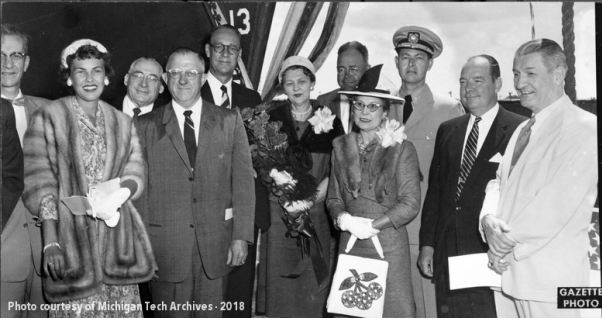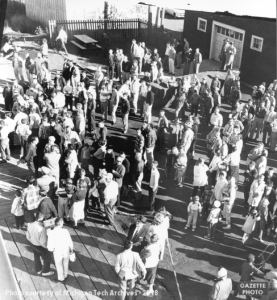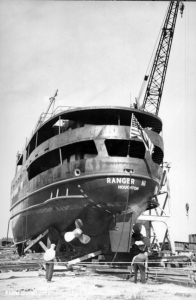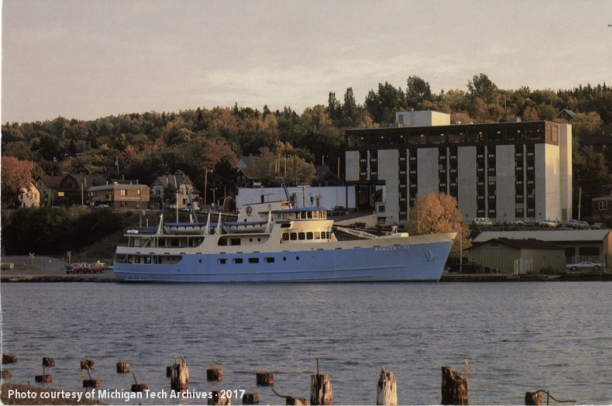
To those who live in or visit the Copper Country, the sight of a large blue and white vessel on the Keweenaw Waterway is a welcome and familiar one. Today’s Flashback Friday looks back to the launch of the Ranger III and remembers those vessels that came before her.
The Ranger III is a 165 foot long, 34 feet wide, 648 ton vessel that can carry up to 128 passengers. The nine-member crew operates the ship with skill to safely navigate the unpredictable waters of Lake Superior, carrying people and cargo back and forth from Houghton, Michigan to Rock Harbor on Isle Royale. The vessel is owned and operated by the National Park Service (NPS.)
The journey to Isle Royale National Park on the Ranger III begins at the home port in Houghton. The six-hour long, 73 mile journey to Rock Harbor starts out through the Keweenaw Waterway, also known as the Portage Canal, and passes under the famous Portage Lift Bridge. The bulk of the journey is spent on the open, majestic waters of Lake Superior and the destination is the rugged, north woods landscape of Isle Royale.

Today’s Flashback Friday looks back to the launch of the vessel, which was covered in the Daily Mining Gazette on this day in 1958. The photo depicts people, widely known locally in the mid-twentieth century, on the occasion of the Ranger III’s launching. Easy to spot are Daniel J. Tobin, regional National Park director; C. R. Christianson, head of the Christy Corp., Congressman and Mrs. John Bennett, Superintendent John Lewis of the Isle Royale Park. Mrs. C. R. Christianson, local Coast Guard Auxiliary head Edward Lieblein and Senator Leo Roy. This photograph was taken in Sturgeon Bay, Wisconsin.

Large vessels were an integral part of the history of Isle Royale and its opening as a national park. The basic idea of establishing a national park like Isle Royale came about in March 1931, when President Herbert Hoover authorized Congress to build a conservation effort around a prime expanse of northern wilderness. During 1937, the effort to open the park received two surplus, wooden hull United States Coast Guard cutters and their two-man crews. These vessels were originally designated NPS-1 and NPS-2, but some confusion led to these boats being renamed and NPS-1 became the first Ranger. While the early cutters served the island well, including during the official establishment of Isle Royale National Park on April 3, 1940, eventually the NPS-2 (the Beaver) was returned to military service and the Ranger fell into disrepair due to lack of proper maintenance during the war. After World War II, the Ranger was taken out of service and replaced by a surplus Army Minelayer, which became the Ranger II. This 114 foot wood ship served Isle Royale from 1946 to 1958.
During the Eisenhower Administration, a nationwide program was initiated to rejuvenate National Park lands and facilities. The program was dubbed “Mission 66” and it provided the opportunity for Isle Royale Park staff to ask for a new ship, the Ranger III. The park’s request was granted and the Christy Corporation of Sturgeon Bay built the ship at a cost of 1.16 million dollars. The Ranger III continues to serve the island to this day and it is currently the largest vessel owned and operated by the National Park Service. For decades the ship has been a symbol of exploration and a welcome sight for children enjoying the local beaches. The wake created by the ship provides large, rolling waves just the right size to rock an inner tube or a canoe.
Full statistics for the USNPS Ranger III can be found on the National Park Service website.
For information about the current schedule, fares, and reservations, please visit the Ranger III Information page on the NPS website.
